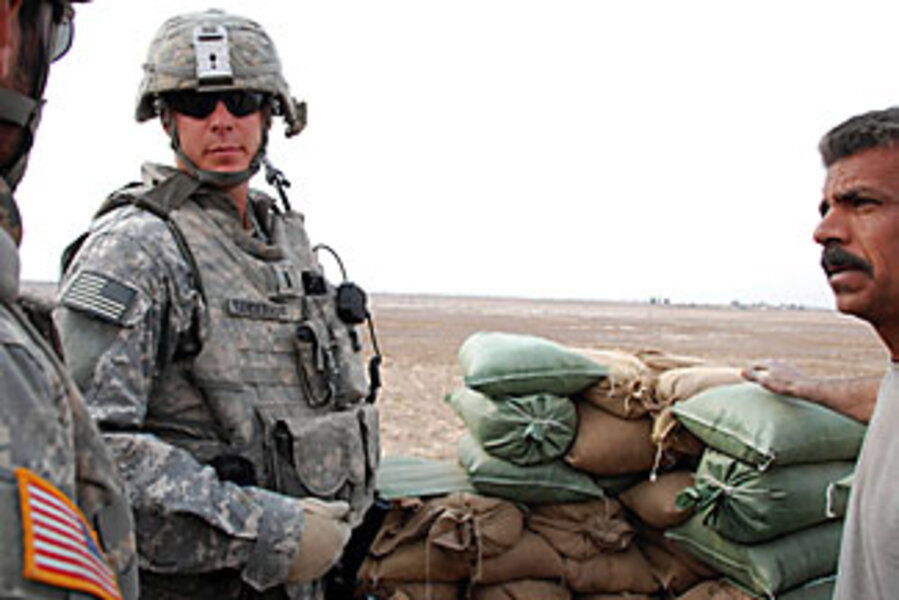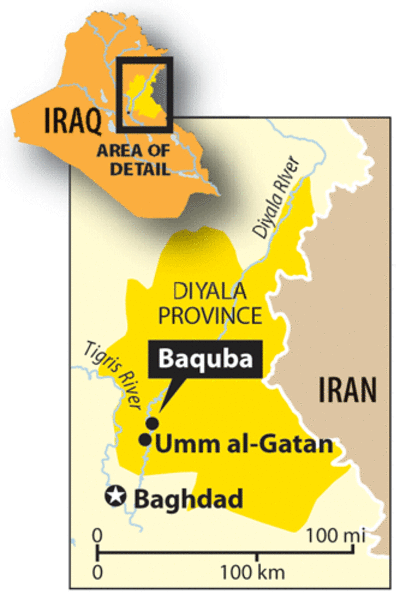Iraq's waning insurgency scrambles for new sanctuary
Loading...
| Baquba, Iraq
Looking across a canal at Umm al-Gatan, a village of about 20 houses, US Army Lt. Drew Vanderhoff is nagged by one of the classic frustrations of counterinsurgency warfare.
"We know for a fact that there is AQI [Al Qaeda in Iraq] in that village," he says. Although he has the names and even biometric data of everyone in the village, 25 miles outside of Baghdad, he's still not sure exactly who's working with the home-grown Sunni insurgent group and who's not.
On his side of the canal, it's a different story though. One soldier from Lieutenant Vanderhoff's platoon notices some new farming projects, a sign that displaced people may be returning as security improves here despite the lingering AQI presence.
Ongoing violence in outlying provinces such as Diyala and Nineveh indicates that although violence has fallen and some normalcy is returning to Baghdad, the fringes of Iraq – the rural towns, farming villages, and desert outposts – have become the new fronts in the fight against the insurgent threat as extremists have fled cities and are hiding in the country's remote corners.
During a joint US-Iraqi patrol, the shadow of an active insurgency loomed large. Searching a dried-up canal, members of Vanderhoff's platoon discovered "spider holes" and tunnels dug into the sides of the empty waterway. Insurgents use these tunnel systems to hide from passing helicopters and stash everything from weapons to motorcycles.
"Everywhere we go people tell us they're here and they're around, so you know they're here," says Staff Sgt. Patrick Wixon. His platoon member, Spc. Chris Calhoun adds, "And in the wintertime they're also not that active," so the present lull in activity may be deceptive.
Still, while fighting insurgents outside major cities has often proved something of a "whack-a-mole" scenario, US forces here say they're finally beginning to make progress thanks in large part to increasingly capable Iraqi security forces and an emboldened local population.
"The trajectory is quite favorable right now, but the question is will [it] be sustained if the US starts to draw down?" asks Austin Long, a counterinsurgency expert at the RAND Corp. in Washington. Around Baghdad there was a "massive US presence with the surge [that helped enable success], which you just didn't have in places like Diyala."
With sectarian tension lessening in Baghdad, AQI has begun shifting its focus to areas with more fragile sectarian and ethnic fault lines. Diyala is home to all three major Iraqi groups – Sunnis, Shiites, and Kurds – which allows AQI greater opportunity to pit rivals against one another to sow discord to create a power vacuum that allows them to exert greater control.
"AQI has been able to play on the sectarian divide a lot more in Diyala, particularly around Baquba, than it has in Anbar [Province] because there basically isn't any sectarian divide there," says Mr. Long. The change has become clear as the number of Iraqi deaths in outer lying provinces now exceeds those in Baghdad. Though the capital traditionally accounted for the majority of fatalities – 54 percent in 2006-07 – in 2008 it was responsible for only 32 percent, according to the Iraq Body Count, an online database of casualties in Iraq.
In Diyala, US commanders say that although they've struggled to make solid gains in the past, they're now beginning to make progress. "We have not destroyed Al Qaeda in Diyala," says Col. Burt Thomson, commander of the 1st Stryker Brigade Combat Team currently stationed in Diyala. "We have forced Al Qaeda to reconsider [its] course of action."
Until recently, US forces struggled to secure Diyala because they lacked adequate troop levels to hold the ground they captured. "We'd come in, do some operations, leave, and they [militants] would come back," says Sgt. Maj. Wayne LaClair of the 2-8 Field Artillery battalion currently stationed in Diyala. In the beginning of the war "we didn't understand how dedicated and hard-core they were," he says.
Now after US forces clear an area, the Iraqi Army, police, or neighborhood watch groups known as Sons of Iraq set up checkpoints along the road to ensure that insurgents don't return. While roadside bombs and harassment of the local population continue, US forces say the situation has dramatically improved.
"This is not the [militant] sanctuary it once was," says Maj. Jon Sowards, executive officer of the 2-8 FA. "They're either on the run or they've got their head down.... The obvious indicator to me is that people are starting to come back."
Indeed, after entire villages emptied during the worst fighting between 2006 and 2008, in just the last three months some local towns have seen as much as a third of the population return.
"From a security standpoint we're getting there," says Maj. Phillip Jenison, operations officer for 2-8 FA. "The remarkable thing is that three or four months ago people were terrified to go down there," he says, speaking about areas where displaced people have returned.






